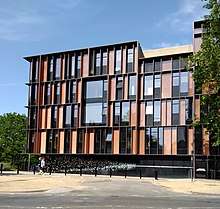John Wheater
John Feather Wheater (born 1958, London) is a British physicist, and Professor specialising in particle physics at the University of Oxford.[5][6][7][8]
John Wheater | |
|---|---|
 John Wheater speaking at St Cross College, Oxford, 25 February 2017[1] | |
| Born | John Feather Wheater 1958 (age 61–62) |
| Nationality | British |
| Citizenship | United Kingdom |
| Alma mater | University of Oxford (BA, DPhil) |
| Home town | Oxford, England |
| Awards | Maxwell Medal and Prize[2] (1993) |
| Scientific career | |
| Fields | Physics Theoretical physics Particle physics |
| Institutions | Durham University University of Oxford |
| Thesis | The Determination of the Electroweak Mixing Angle from Experiments (1981) |
| Doctoral advisor | Christopher Llewellyn Smith |
| Doctoral students | Simon Catterall[3] Neil Ferguson[4] |
| Website | www2 |
Education
Wheater was educated at the University of Oxford where he read Physics at Christ Church, Oxford, during 1976–79, graduating with a first class degree, also winning the Scott Prize for Physics.[5] He undertook a DPhil degree on electroweak radiative corrections, supervised by Chris Llewellyn Smith during 1979–81.[3]
Career and research
Wheater was a Junior Research Fellow in theoretical physics at Christ Church during 1981–84. In 1984–85, he was a lecturer in theoretical particle physics at Durham University.
In 1985, Wheater joined the academic staff of the Department of Physics at Oxford University, initially as a lecturer. He was also been a Fellow of University College, Oxford from 1985 until 2015.[7] During 1990 and later in 2003–4, he was on sabbatical leave spent at the Niels Bohr Institute in Copenhagen, Denmark. In 1993, he was awarded the Maxwell Medal and Prize by the Institute of Physics.[2] He was Head of the Physics Department between 2010 and 2018. In 2015, he was appointed as Professor of Physics. Wheater leads the Particle Theory Group.[9]

During Wheater's term as Head of the Department of Physics, the new Beecroft Building in the department was initiated.[10][11] It was opened in 2018 by Sir Tim Berners-Lee (who formerly studied physics at Oxford),[12] in the presence of Wheater as Head of Department, Professor Louise Richardson (Vice-Chancellor of Oxford), Lord Patten of Barnes (Chancellor of Oxford), and Adrian Beecroft (part-funder of the building).[13]
In 2018–19, Wheater was invited to be a Visiting Professor at the QMATH-center in the Department of Mathematical Sciences at the University of Copenhagen, Denmark.[14][15]
Wheater's former doctoral students include Neil Ferguson,[4] who initially studied physics at Oxford University, but later became an epidemiologist and professor of mathematical biology at Imperial College London and was an influential scientist in the UK government strategy for the COVID-19 pandemic in the United Kingdom.[16]
Selected publications
Wheater publications[5][17][18] include:
- Low-energy predictions from grand unified theories[19]
- C.H.L. Smith, J.F. Wheater, Electroweak radiative corrections and the value of sin2θW. Physics Letters B, 1981.
- J.F. Wheater, C.H.L. Smith, Electroweak radiative corrections to neutrino and electron scattering and the value of sin2θW. Nuclear Physics B, 1982.
- I.I. Kogan, N.E. Mavromatos, J.F. Wheater, D-brane recoil and logarithmic operators. Physics Letters B, 1996.
- P. Austing, J.F. Wheater, Convergent Yang-Mills matrix theories. Journal of High Energy Physics, 2001.
Personal life
Wheater is married with two daughters.[5]
References
- St Cross College (2 March 2017). "The Émigrés in Oxford Physics – HAPP Centre – Professor John Wheater". YouTube. Retrieved 11 April 2020.
- "Maxwell medal recipients". Institute of Physics. Retrieved 11 April 2020.
- "John F. Wheater". Physics Tree. Academic Tree. Retrieved 10 April 2020.
- Ferguson, Neil Morris (1994). Continuous interpolations from crystalline to dynamically triangulated random surfaces. bodleian.ox.ac.uk (DPhil thesis). University of Oxford. OCLC 556755377. EThOS uk.bl.ethos.239308.
- Wheater, John F. (2015). "Curriculum Vitae: John Feather WHEATER" (PDF). Department of Physics, University of Oxford. Retrieved 10 April 2020.
- "John Wheater". UK: Department of Physics, University of Oxford. Retrieved 20 April 2020.
- "John Wheater". UK: University College, Oxford. Retrieved 20 April 2020.
- "John Wheater". UK: Theoretical Physics, University of Oxford. Retrieved 20 April 2020.
- "Particle Theory". UK: Department of Physics, University of Oxford. Retrieved 10 April 2020.
- "Planet Partitioning secure contract for University of Oxford's the Beecroft building". UK: Planet Partitioning. 14 March 2017. Retrieved 10 April 2020.
- "Beecroft Building, University of Oxford". Hawkins\Brown. 2020. Retrieved 10 April 2020.
- "The Beecroft Building". UK: Department of Physics, University of Oxford. Retrieved 11 April 2020.
- University of Oxford (27 September 2018). "The opening of Oxford's Beecroft Building". YouTube. Retrieved 11 April 2020.
- "Professor John Wheater, guest at QMATH". Denmark: Department of Mathematical Sciences, University of Copenhagen. 21 December 2018. Retrieved 11 April 2020.
- "John Wheater". ORCID. Retrieved 10 April 2020.
- Clark, Pilita (20 March 2020). "Neil Ferguson, a virus modeller sounds the alarm". Financial Times. Retrieved 10 April 2020.
- "John Wheater – publications". UK: Department of Physics, University of Oxford. Retrieved 10 April 2020.
- "John F. Wheater's articles on arXiv". arXiv. USA: Cornell University. Retrieved 10 April 2020.
- C.H.L. Smith, G.G. Ross, J.F. Wheater, Low-energy predictions from grand unified theories. Nuclear Physics B, 1981. doi:10.1016/0550-3213(81)90391-6